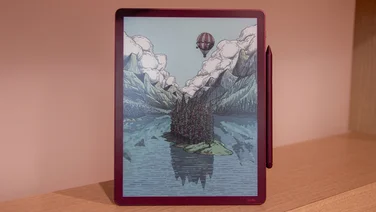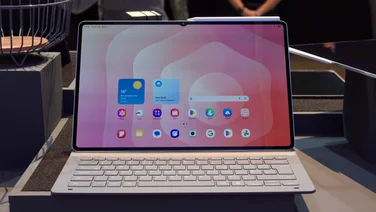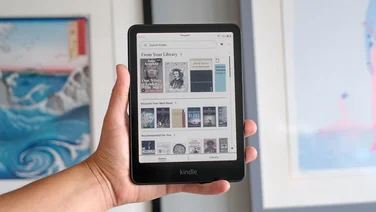To help us provide you with free impartial advice, we may earn a commission if you buy through links on our site. Learn more











- Compact and pocketable
- Responsive and usable
- Can install Kindle app and read books
- Nowhere to attach stylus
- Resolution of colour images and text is low
We’ve seen quite a few digital note-taking ereaders emerge in recent times, but the Boox Palma 2 Pro falls into a relatively new category – for me at least. Where most e-readers tend to focus on a fairly narrow feature set, the Boox is all-encompassing.
You can use this compact e-ink device as an ebook reader and note-taker if you want, but that would be to miss the point. In fact, it’s closer to a phone than it is an e-reader, both in size and function, despite the presence of a colour e-ink display. It even comes with a camera on the rear. The only thing it can’t do, it seems, is to make phone calls and play videos.
What you get for the money
For the privilege of owning such a multi-talented device, however, you are paying a premium. It costs €400 (~£352), a price that rises to €433 (~£382) if you want the InkSense Plus pen and case to go with it.
That’s considerably more expensive than a regular e-reader, even a top-of-the-range one like the Kindle Colorsoft. It is, however, around the same price as you’ll pay for the slightly larger Remarkable Paper Pro Move, also a compact digital note-taker, and that can’t do half the things the Palma 2 Pro can.
So what makes this dinky jotter so different? For starters, it’s probably the smallest e-reader-type device I’ve used. It has a colour e-ink display that measures a mere 6.13in across the diagonal, and it feels like a phone to hold and use. The design is a little old-fashioned with thick chin and forehead bezels, a plastic frame and a rough, textured back, plus it’s rather thick and heavy, but I think it has a charm all of its own.











It’s not just the size that makes this device like a phone, though. Other features include the aforementioned camera – a 16MP unit with a single LED flash – a fingerprint reader built into the power button for quick unlocking, built-in speakers and microphones, there’s Bluetooth wireless connectivity for headphones and peripherals, plus a nano-SIM card tray for cellular connectivity and a microSD card expansion. The CPU is an octa-core effort – you get 8GB of RAM and 128GB of storage as standard – and there’s even built-in GPS.
Perhaps the Palma 2 Pro’s most significant feature, however, is that it runs full-fat Android 15, meaning you can install apps from Google Play and run them just as you would on any regular phone or tablet. As I said, just about the only thing it doesn’t do is allow you to take and make phone calls, and the e-ink screen doesn’t refresh quickly enough to make watching videos or playing action-based games a practical possibility, either.
What does it do well?
For an e-ink device, the Palma 2 Pro is a pretty slick performer. I’ve become used to fairly slow response times over the years from this type of product, so much so that I’d discounted the technology for applications like browsing the web or scrolling through social media feeds. This device is different.
It’s much more responsive to taps and swipes than any other e-ink product I’ve used and although the colour is nowhere near as vibrant as what you’d get with a phone – even basic graphics look coarse and dull – the very fact that you can scroll, zoom and pan without having to wait for a second for the screen to redraw feels faintly miraculous.











The screen itself is excellent, in particular the front light, which can be turned up very bright and tuned to a less sleep-disrupting amber hue for reading at night. It uses the same Kaleido 3 technology as the Amazon Kindle Colorsoft, which overlays an RGB filter over the top, so images and text don’t look quite as immediate and “on the page” as they do on the Remarkable Paper Pro Move. But I did appreciate the occasional splash of colour, and it’s useful for annotation.
It’s the ability to install Android apps, though, that really sets this thing apart. And, yes, that means you can install the Kindle reading app and download and access your existing library, or the Kobo app or the Libby app for digital library loans.
It also means you can use any other app you care to install. I added WhatsApp (in companion mode), Google Maps, NYT Games, Apple Music and BBC Sounds, and for the most part, I had no problem using them. Occasionally, some part of the UI would fail to show up on screen – empty squares on the Wordle puzzle, for instance – but that was a rarity.











Of course, the main purpose of a device like this is to take notes, to jot ideas down, annotate or otherwise markup documents and to read text. And, largely, it’s pretty darned good at all these things. I particularly liked the way you can annotate anything onscreen using the FreeMark facility. Although this is essentially a repackaged screenshot tool, the way it works is quite clever: simply engage the Control Centre with a downwards swipe from the top of the screen, tap the FreeMark shortcut button, scribble away – then you can save the screenshot, share it or insert it into an existing notebook.
Regular handwritten notes are handled by Boox’s own notes app, which I found worked reasonably well. It doesn’t quite have the same broad selection of paper template backgrounds as the Remarkable does, but it strikes back with features such as embedded audio recording. And a wider range of pen styles and customisability.











Another standout feature is the degree to which you can customise the way the colour e-ink screen behaves. Using Boox’s EinkWise tool, you can tweak how vividly it appears, the frequency with which it flickers/redraws itself, and so on. This makes it relatively easy to balance how much ghosting or image retention there is with how quickly you can scroll, pan and so on. Even better, there are three preset modes to make switching between modes easier – Recommended for best image quality, Fast for activities involving scrolling, panning and zooming and your own preset in Customise.
And don’t forget that because the screen technology is more efficient than LCD or OLED, the battery life will far outstrip that of a regular phone. As I sit here writing this review, I’ve used the Palma to take notes for an hour, I’ve browsed the web to catch up on the news in the morning, and I’ve spent 20 minutes or so reading a book. The battery life has dipped by at most five per cent since I woke up, and it’s now early afternoon.
What could it do better?
The first complaint I have about the Palma 2 Pro is that it feels a little cramped when taking notes, although I suppose if you want a device this small, you do have to make compromises. Something the designers could have avoided, however, is the fact that when you place the device on a flat surface like a desk, it does rock slightly, thanks to the back not being completely flat. I’d advise leaving it in a case for that reason.
And although I liked writing on the screen, it’s not the best feeling note-taker I’ve used. There’s plenty of friction between the nib and the screen surface, and the stylus feels precise to use, but it isn’t as immediate or realistic an experience as the Remarkable Paper Pro Move.











There’s nowhere to stow the stylus on or in the body of the Palma 2 Pro, either. It attaches magnetically to the clip on the case that comes supplied with the InkSense bundle, but that’s not the most elegant solution, and the pen is dislodged rather too easily for my liking. Plus, when it runs out of battery, you have to charge it via USB-C. Once again, the Remarkable Paper Pro Move deploys a more elegant method: its pen docks firmly to the right edge of the reader, and it charges while attached.
One further moan I have with the stylus is that it isn’t universally compatible across all Boox devices. This only comes into play if you own another Boox device – say the larger Boox Air Note 5c – but it seems a bit odd to use two different technologies and, potentially, somewhat wasteful.
Finally, it’s worth noting that the resolution of this screen in colour isn’t very high. The pixel density is only 150ppi in colour, half what it is in monochrome (300ppi), which means that images and graphics can look rather coarse. And the speakers sound rather tinny and harsh – worth bearing in mind if you plan on using the Palma to listen to audiobooks while pottering around at home.
Should you buy the Boox Palma 2 Pro?
Despite its shortcomings, the Boox Palma 2 Pro is a rather likeable little device. It’s a pocketable e-reader with phone-like capabilities and great battery life. You can take handwritten or voice notes on it. You can read your Kindle books or books from any other provider. You can install any app from Google Play, for that matter. And it’s surprisingly responsive when browsing the web.
However, as with many devices that are a Jack of all trades, the Boox Palma 2 Pro is not the master of any of them. It isn’t the best compact note-taker; for that use case, I’d choose the Remarkable Paper Pro Move. It isn’t the best e-reader, although it is highly flexible. And it isn’t a phone, even though it seems to want to be. Last, but by no means least, it is rather expensive.
There will be a small segment of people who want exactly what the Palma 2 Pro provides. Coupled with a dumb phone, it might provide a way of detaching yourself from the daily grind of online video addiction. But, really, I can’t imagine many people taking advantage of its many talents.

















